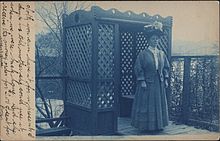Cyanotype is a photographic printing process that produces a cyan-blue print. The process was discovered in 1842 by English scientist and astronomer. Engineers used the process well into the 20th century as a simple and low-cost process to produce copies of drawings, referred to as blueprints.
Process
Prints can be made from large format negatives and lithography film, Digital negative (transparency) or everyday objects can be used to make photograms.
The process uses two chemicals:ferric ammonium citrate andpotassium ferricyanide.
In a typical procedure, equal volumes of an 8.1% solution of potassium ferricyanide and a 20% solution of ferric ammonium citrate are mixed. The overall contrast of the sensitizer solution can be increased with the addition of approximately 6 drops of 1% solution potassium dichromate for every 2ml of sensitiser solution.
This mildly photosensitive solution is then applied to a receptive surface (such as paper or cloth) and allowed to dry in a dark place. Cyanotypes can be printed on any surface capable of soaking up the iron solution. Although watercolour paper is a preferred medium, cotton, wool and even gelatin sizing on nonporous surfaces have been used. Care should be taken to avoid alkaline-buffered papers, which degrade the image over time.
A positive image can be produced by exposing it to a source of ultraviolet light (such as sunlight) as contact print through the negative (traditionally, semitransparent paper) or objects. The combination of UV light and the citrate reduces the iron(III) to iron(II). This is followed by a complex reaction of the iron(II) complex with ferricyanide. The result is an insoluble, blue dye (ferric ferrocyanide) known as Prussian blue. The extent of colour change depends on the amount of UV light, but acceptable results are usually obtained after 10–20 minute exposures on a dark, gloomy day.
After exposure, developing of the picture involves the yellow unreacted iron solution being rinsed off with running water. Although the blue colour darkens upon drying, the effect can be accelerated by soaking the print in a 6% (v/v) solution of 3% (household).The water-soluble iron(III) salts are washed away, while the non-water-soluble Prussian blue remains in the paper. The highlight values should appear overexposed, as the water wash reduces the final print values.
Toning
In a cyanotype, a blue is usually the desired color; however, there are a variety of effects that can be achieved. These fall into three categories: reducing, intensifying, and toning:
- Reducing is the process of reducing or decreasing the intensity of the blue. Sodium carbonate, ammonia, Clorox, TSP, borax, Dektol and other chemicals can be used to do this. A good easily obtained reducer is bleach. How much and how long to bleach depends on the image content, emulsion thickness and what kind of toning is being used. When using a reducer it is important to pull the cyanotype out of the weak solution and put the cyanotype into a water bath to arrest the bleaching process.
- Intensifying is the strengthening of the blue effect. These chemicals can also be used to expedite the oxidation process the cyanotype undergoes. These chemicals are hydrogen peroxide, citric acid, lemon juice, and vinegar.
- Toning is the process used to change the colour of the iron in the print cyanotype. The colour change varies with the reagent used. There are a variety of elements that can be used, including tannic acid, oolong tea, wine, cat urine, and pyrogallic acid
Long-term preservation
In contrast to most historical and present-day processes, cyanotype prints do not react well to basic environments. As a result, it is not advised to store or present the print in chemically buffered museum board, as this makes the image fade.
Another unusual characteristic of the cyanotype is its regenerative behavior: prints that have faded due to prolonged exposure to light can often be significantly restored to their original tone by simply temporarily storing them in a dark environment.
Cyanotypes on cloth are permanent but must be washed by hand with non-phosphate soapso as to not turn the cyan to yellow.
Artists
Artists using the process include:
- Anna Atkins who created a series of cyanotype limited-edition books that documented ferns and other plant life from her extensive seaweed collection, placing specimens directly onto coated paper and allowing the action of light to create a silhouette effect. By using this photogram process, Anna Atkins is sometimes considered the first female photographer.
Contemporary artists who employ the cyanotype process in their art include:

Cyanotype postcard, Racine, Wis., c. 1910